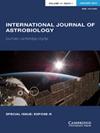长时间测序显示,在国际空间站上长时间飞行暴露后,短小芽孢杆菌SAFR-32基因组变异和腺苷甲基化的发生率增加
IF 1
4区 物理与天体物理
Q3 ASTRONOMY & ASTROPHYSICS
引用次数: 2
摘要
在国际空间站(ISS)上直接暴露于太空条件1.5年后,对一种内孔形成细菌株短小芽孢杆菌SAFR-32进行了研究,以确定其甲基化模式(甲基组)与地面对照相比的变化。使用Nanopore Mineion和内部方法和管道对ISS飞行和非飞行菌株进行测序,以确定基因组中的甲基化位置。我们的分析表明,在国际空间站飞行的SAFR-32中,基因组变异和m6A甲基化增加。为了补充更广泛的组学研究并探索表型变化,在一系列基于实验室的室内实验中,使用X射线辐射源(剂量为2505007501000和1250Gy)对ISS飞行菌株和非飞行菌株进行了比较;结果显示,ISS飞行的DS2在两次最高暴露下的存活率可能更高。总之,这项研究的结果记录了甲基化对基因组的持久变化,甲基化可能是由太空飞行条件引发的,对细菌抵抗近地轨道以外的长期任务中预期的压力源具有功能性影响。本文章由计算机程序翻译,如有差异,请以英文原文为准。
Long-read sequencing reveals increased occurrence of genomic variants and adenosine methylation in Bacillus pumilus SAFR-032 after long-duration flight exposure onboard the International Space Station
Bacillus pumilus SAFR-032, an endospore-forming bacterial strain, was investigated to determine its methylation pattern (methylome) change, compared to ground control, after direct exposure to space conditions onboard the International Space Station (ISS) for 1.5 years. The resulting ISS-flown and non-flown strains were sequenced using the Nanopore MinION and an in-house method and pipeline to identify methylated positions in the genome. Our analysis indicated genomic variants and m6A methylation increased in the ISS-flown SAFR-032. To complement the broader omics investigation and explore phenotypic changes, ISS-flown and non-flown strains were compared in a series of laboratory-based chamber experiments using an X-ray irradiation source (doses applied at 250, 500, 750, 1000 and 1250 Gy); results show a potentially higher survival fraction of ISS-flown DS2 at the two highest exposures. Taken together, results from this study document lasting changes to the genome by methylation, potentially triggered by conditions in spaceflight, with functional consequences for the resistance of bacteria to stressors expected on long-duration missions beyond low Earth orbit.
求助全文
通过发布文献求助,成功后即可免费获取论文全文。
去求助
来源期刊

International Journal of Astrobiology
地学天文-地球科学综合
CiteScore
3.70
自引率
11.80%
发文量
45
审稿时长
>12 weeks
期刊介绍:
International Journal of Astrobiology is the peer-reviewed forum for practitioners in this exciting interdisciplinary field. Coverage includes cosmic prebiotic chemistry, planetary evolution, the search for planetary systems and habitable zones, extremophile biology and experimental simulation of extraterrestrial environments, Mars as an abode of life, life detection in our solar system and beyond, the search for extraterrestrial intelligence, the history of the science of astrobiology, as well as societal and educational aspects of astrobiology. Occasionally an issue of the journal is devoted to the keynote plenary research papers from an international meeting. A notable feature of the journal is the global distribution of its authors.
 求助内容:
求助内容: 应助结果提醒方式:
应助结果提醒方式:


